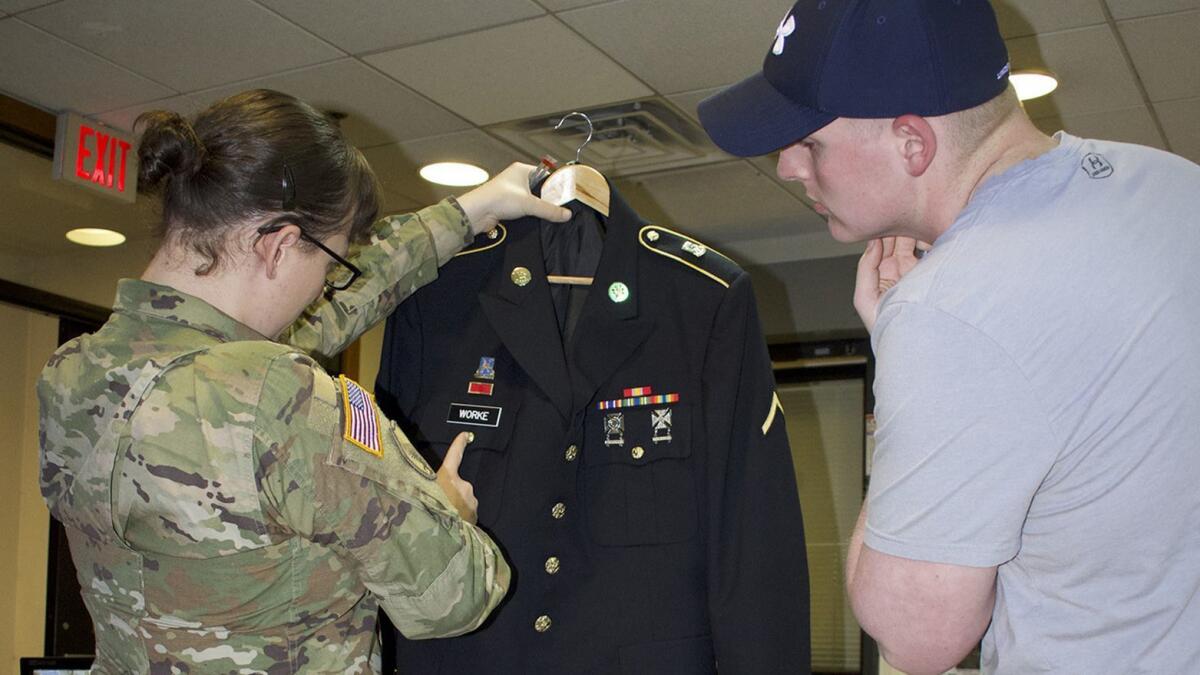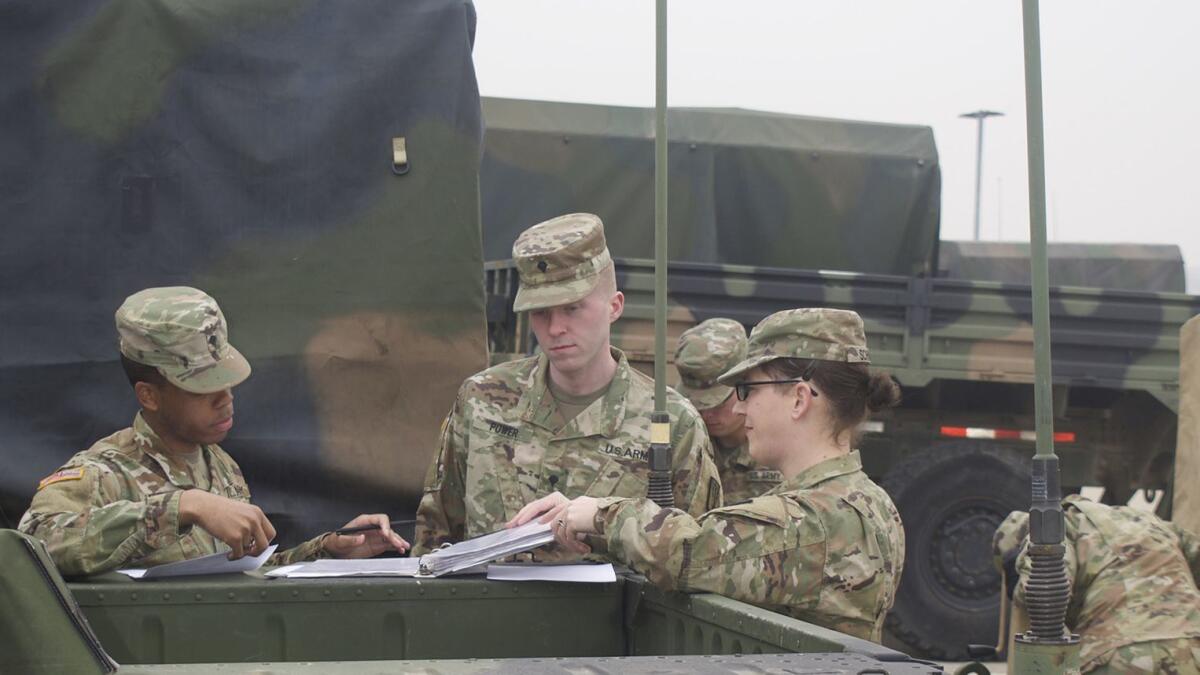A transgender soldier who fought to wear the Army uniform wonders if it still fits

L.A. Times Today airs Monday through Friday at 7 p.m. and 10 p.m. on Spectrum News 1.
Cathrine Schmid longed to be a soldier. To wear the uniform her grandfather wore.
She had a secret reason too: to belong somewhere that would suppress her innermost self.
“Maybe the Army will make these feelings go away,” she told herself. “The Army will make a man out of me.”
That was 14 years ago, when, as a man, she enlisted. Schmid wore the uniform and guarded her secret self at military bases in Missouri, Arizona, Germany, Kansas, Florida, Iraq, Washington and Korea.
The Army didn’t change her, hard as it, and she, tried. Instead, in eventually becoming herself, Schmid took part in a still uncertain effort to change the Army.
When she finally put on the uniform that felt right — the dress blues with knee-length skirt and gold braid — she danced for joy with her spouse in front of soldiers who had known her as a man. Maybe for the first time she belonged.
Maybe the Army will make these feelings go away ... make a man out of me.
— Cathrine Schmid
But now, the military that embraced Schmid has been directed once again to shun soldiers like her. A ban ordered by President Trump went into effect April 12, overturning a 3-year-old Pentagon directive that said transgender soldiers would no longer be forced to hide.
“In June I’m up for promotion again,” the 34-year-old Schmid said in a Twitter message last month. “What is the likelihood that I am considered based on my merits and not on the fact that I’m trans?” The Times contacted her after seeing her Twitter feed, and she agreed to be interviewed.
In Army parlance, Schmid is a 35N, a signals intelligence analyst. She heads an eight-soldier team in the 532nd Military Intelligence Battalion that processes intercepted communications traffic from North Korea.
Timeline: Transgender service members and the military »
Intelligence is the Army’s nerd clique, less macho and more accepting than a hard-core infantry company.
“I know her as female Sgt. Schmid, and she’s been a blessing,” said a noncommissioned officer. “I wish I had more like her,” he added, asking not to be identified given the uncertain climate.
Small and athletic, in horn-rim glasses, Schmid sits at the front desk just inside her barracks, a dun-colored building at Camp Humphreys, her base far away from a former life.
It’s her turn for staff duty, an all-night shift walking hallways and keeping tabs on her “Joes,” 18- and 19-year old privates on their first overseas deployment. They’re off duty, in sweat pants and hoodies, more like freshmen in a dorm than soldiers in a barracks.

One by one, several walk up to Schmid carrying dress-blue uniforms on hangers.
A formal battalion dinner is coming up, and they want to look squared away. Schmid, with the stripes of a staff sergeant and her wavy brown hair in a regulation Army bun, is the authority on uniforms — an irony given a history that few of the Joes fully know.
She lays the jackets on the desk and pulls out a slim silver ruler.
Is the nameplate centered on the left pocket flap, as regulations require? Are the badges one-eighth of an inch above the pocket? Not quite. She tells a hulking private that the brass U.S. medallions on his lapels are tarnished. Use a Q-tip, she says. He nods.
A female soldier in fuzzy slippers says her blues sometimes look askew, the badges and insignias off-kilter. She can’t figure out why.
“Wear the same bra every time,” Schmid advises.
“Thanks, staff sergeant.”
For years, it was Schmid’s uniform, and life, that felt askew.
She came from a religious family with a strict father who served in the Air Force. In her childhood, they lived on a remote airbase in northern Michigan. At night, she says, she wrapped herself in her blanket.
“Like a cocoon, so that when I woke up, I’d have metamorphosed into a girl.”
Schmid carried the secret through high school in Gresham, Ore., and in 2002 enrolled in Bible college. She flunked out a semester later. She worked as an appliance repairman and married her high school girlfriend.
“I had spent my entire life trying to overcome dysphoria through every means — prayer, hard work and good old-fashioned heterosexual activity,” she said.
Two months after her wedding, Schmid enlisted in the Army for reasons not that different from those that drove other young, male recruits — patriotism, steady pay, escape from a dead end. To prove something.
The Army’s rigid rules weren’t the refuge she hoped.
I had spent my entire life trying to overcome dysphoria through every means.
— Cathrine Schmid
Schmid was reprimanded for taking another soldier’s helmet when she couldn’t find hers. Sometimes she’d hide lip gloss or some other feminine item “like a talisman” in her uniform pocket. She’d create social media accounts under a female name.
“Then I’d feel overwhelmed with shame and purge everything, and swear to never do it again,” she said.
Schmid’s wife knew of her gender uncertainty and wondered whether their marriage could last, even as Schmid vowed she had no desire to transition to a woman.
In public, Schmid was a husband and father. A daughter was born in 2007 while the Schmids were stationed in Germany. Another daughter arrived five years later. She watched her words, trying not to sound feminine, worried that others suspected her.
In private, there was furtive cross-dressing, depression and suicidal thoughts.
After checking into the base hospital in 2008, she told therapists that she didn’t want to be male. They warned that seeking treatment for gender dysphoria could end her Army career. Forget what I said, she told them.
Three years later, in her first South Korea tour, she and her wife recorded a video, smiling, hugging their daughters and waving in a Christmas greeting recorded by the Pentagon’s “Hometown News Service” for their families back in the U.S.
“We want to say to all the family back in Oregon, Merry Christmas,” the video shows them saying.

By 2013, she was in Iraq, alone in her quarters with time to think, filling a journal with math problems and musings about a failing marriage.
One day, in the margin of a page, she wrote in tiny block letters: “I think I am transgender.”
It was the first time she had spelled out the word. A few weeks later, she said it out loud in a phone call with her wife, who was living at the couple’s house near MacDill Air Force Base in Tampa, Fla.
Schmid’s wife asked for a divorce and took the children to Oregon. The breakup left Schmid once again suicidal.
“I drove to the Tampa Bay Bridge and stood there, ready to jump,” she said. She called a crisis hotline instead and was hospitalized for a month at MacDill’s health clinic.
Schmid begged her therapist not to tell her commander about her identity. When the doctor said he had no choice, she decided the only chance of saving her career was to out herself.
It was, she said, the hardest ordeal of her life.
“I have been diagnosed with gender dysphoria,” she told the captain in the clinic conference room, reading from a one-page memo she wrote. “This diagnosis is something I have fought my entire life, avoiding the negative impacts on my family and my military career.”
Even more than in the civilian world, trans service members in the U.S. — estimates of their number range from just over 2,000 to 15,000 — were expected to stay invisible. They were officially deemed unfit for service, lumped with voyeurs and exhibitionists in the military’s eligibility standards.
The Defense Department rules required trans people “to hide and lie about themselves,” Schmid told the captain.
Until the regulations were changed, Schmid promised not to begin hormones or “any surgical procedures” to change gender. But “I am convinced that informing my chain of command and being honest to myself and others will help alleviate many negative psychological symptoms and make me a better soldier.”
Therefore, she concluded, “It is my request that I, in the face of extenuating circumstances, may continue my service in the U.S. Army.”
Calling Schmid back to the room 20 minutes later, the captain said coldly he would not discharge her as long as she didn’t slip up.
The decision left Schmid elated but in limbo. She was out of the closet, but still had to live as a male while on duty. That proved harder in some ways than living in denial.
She was briefing senior officers at U.S. Central Command headquarters on Middle East intelligence, while enduring snap inspections from senior noncommissioned officers, who tried to catch her violating Army rules on uniforms and grooming.
Someone reported her for wearing nail polish after she buffed her nails to make them shine. One soldier posted on Facebook that he worked with a “tranny.” Her hair length was checked to make sure it complied with male haircut standards.
A Facebook picture she posted of herself wearing makeup drew a reprimand.
Behind the story: How a transgender soldier learned to be herself »
Away from work, Schmid took the first steps toward transitioning, with a boldness she had never allowed herself before. She remarried to a spouse who was herself transgender. She took to calling herself a “humanist,” abandoning the religion of her childhood.
“I’m never going back,” she told herself, even after her best friend from childhood shunned her.
A few months later, she legally changed her name to Cathrine.
When her commanders heard, they “reamed me out” at a four-hour meeting, accusing her of “bringing my personal life to work.” She left in tears. But an investigation into whether she could be discharged found she had not violated any rules.
Others went out of their way to be supportive. A sergeant invited Schmid and her spouse to Thanksgiving at his house after Schmid’s parents told her not to fly home to Oregon for the holiday because they weren’t ready to accept her as a woman.
And within the military hierarchy, the climate for transgender soldiers was changing. When Schmid was reassigned to Joint Base Lewis-McChord outside Tacoma, Wash., in March 2016, her new unit halted the harassing inspections.
Five years earlier, the law ending the military’s “don’t ask, don’t tell” rule had gone into effect. Now, rumors spread that the Obama administration would shortly lift the transgender ban.
In June of that year, her new commander permitted her to wear a female uniform for the first time at the annual Army Ball. Since the event at a Tacoma hotel was technically after duty hours, he reasoned that the rule prohibiting a male soldier from donning female dress blues didn’t apply.
Schmid and her wife danced surrounded on the ballroom floor by other soldiers, feeling like she “wasn’t ostracized anymore,” she said.
Two months later, the Pentagon lifted the transgender ban. She began hormone therapy, changed her gender designation to female in Army personnel records, and was preparing to undergo gender reassignment surgery.
On July 26, 2017, a little before 6:30 a.m. in Korea, she received a phone alert that Trump was restoring the transgender ban. Due at morning formation minutes later, she stared at the screen in disbelief.
“After consultation with my generals and military experts, please be advised that the United States government will not accept or allow transgender individuals to serve in any capacity in the U.S. military,” Trump wrote in a series of Twitter messages. The armed forces “cannot be burdened” with the “disruption that transgender in the military would entail.”
Instead of a planned four-mile run with her unit, Schmid asked for permission to run by herself. She headed deep into the backwoods on the base.
But rather than returning to silence, Schmid joined the lawsuit filed against the new ban in federal court in Washington state, declaring in an affidavit that Trump’s action “throws my future and livelihood into jeopardy.”
She went through with her gender surgery last August, though she had to appeal directly to the Army surgeon general to get consent for the procedure. The approval came only 12 hours before her procedure was scheduled at a private clinic in Arizona. She spent two weeks on light duty while recovering and then deployed to Korea with her unit a few months later.
Because her dysphoria diagnosis was treated before Trump’s policy took effect, Schmid is not in immediate danger of being discharged. But other trans service members who have not yet come out face removal or life in the closet.
In her off-hours, Schmid fields desperate messages from some of them asking for advice. She forwards them copies of the memos she wrote her commanders, pleading for the same loyalty that the Army demands of its soldiers.
She hates the idea that the Army she has come to love is once again treating trans soldiers like outcasts. She thought the fight was won. She thought the uniform finally fit.
More to Read
Get the L.A. Times Politics newsletter
Deeply reported insights into legislation, politics and policy from Sacramento, Washington and beyond. In your inbox three times per week.
You may occasionally receive promotional content from the Los Angeles Times.







